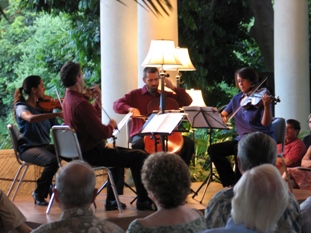 Southwest Chamber Music continued its great summer concert series at the Huntington Saturday and Sunday, Aug. 7 and 8, with music by Debussy, Ravel, Satie, and well-known local composer Anne Le Baron.
Southwest Chamber Music continued its great summer concert series at the Huntington Saturday and Sunday, Aug. 7 and 8, with music by Debussy, Ravel, Satie, and well-known local composer Anne Le Baron.
Debussy’s Danse sacrée et danse profane attracted me to the concert to begin with – and I was not disappointed. Alison Bjorkedal’s harp swept us away. She is an extraordinary harpist, and her Debussy was right in the zone. Her technique was flawless, her artistry inspired. The music was so beautiful, so affective, so potent, that its effect defies language. Merci!
With the starry Los Angeles summer sky in the background, Bjorkedal was then joined by flutist Larry Kaplan in a unique transcription of Satie’s Le Fils des étoiles, realized in this arrangement by Japanese composer Toru Takemitsu. The connection between French and Asian musical traditions was underscored in Jeff von der Schmidt’s remarks, and this composition was a fine example. An ebb and flow of ambiguous harmony unencumbered by cadence yielded attention to Kaplan’s sonorous melody. Takemitsu’s setting was totally rational and easy to understand, and Bjorkedal’s and Kaplan’s portrayal was vivid.
Southwest Chamber Music is known for showcasing living local and international composers, including women, mixed with the cultural roots we share.
Le Baron’s Solar Music was mesmerizing. The composer was in attendance, and in her remarks said that the pre-existing title was apropos to the dynamic of her work although was chosen post-hoc to its composition. The reference is to Mexican surrealist painter Remedios Varo’s work with “a woman standing in a dying forest, bowing rays of the sun.”
Solar Music includes unorthodox sounds that combine into an ethereal music of creative technique. Bjorkedal supplemented her technical abilities on the harp with resonant taps and slaps, string preparations, and various detunings; the ending sounded a bowed harp played using a screwdriver as a sort of slide.
Kaplan was marvelous as he squeezed and teased a smooth flow of ever-changing timbres from the entire family of flutes. He developed a sonic pallet of multiphonics, harmonics, alternate fingerings, bends, quartertones, use of voice, and all manner of attack into a masterfully expressive performance. The ride was Messiaen-like as the colors of the spectrum, from the bass flute to the alto to the standard to the piccolo, flowed in an ever-rising sequence.
Ravel’s Introduction and Allegro required the largest ensemble of the program, and the sound and its energy resonated hugely with the audience. Clarinetist Jim Foscia’s arpeggios were quick and delicate, and his role was significant. Kaplan and Foscia both sounded large, especially in duet. In fact, the whole ensemble was rich and authentic, and on the whole Ravel was the best performed and received of the evening.
The Debussy String Quartet is literally one-of-a-kind, and the performance was en française with joie de vivre that infused the space with a delectable perfumed sound. Jan Karlin’s viola had an exquisite tone that was accentuated by a gentle technique and her keen sensitivity to the music and the other voices in the ensemble. Peter Jacobson’s cello touch was light, yet still deliberate, and especially in consort with Karlin, it impressed an unmistakable structure and forward motion onto the sound. Lorenz Gamma and Shalini Vijayan added a delicate sheen to the sound that was brilliant.
Southwest Chamber Music ends its summer series at the Huntington with two concerts next weekend, Aug. 21 and 22.





